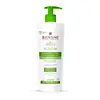What's inside
What's inside
 Key Ingredients
Key Ingredients

 Benefits
Benefits

 Concerns
Concerns

 Ingredients Side-by-side
Ingredients Side-by-side

Water
Skin ConditioningGlycerin
HumectantPropylene Glycol
HumectantSodium Laureth Sulfate
CleansingNiacinamide
SmoothingCocamidopropyl Betaine
CleansingAcrylates/C10-30 Alkyl Acrylate Crosspolymer
Emulsion StabilisingMethyl Gluceth-20
HumectantPentylene Glycol
Skin ConditioningPhenoxyethanol
PreservativeSodium PCA
HumectantAlcohol
AntimicrobialBenzoic Acid
MaskingCurcuma Longa Root Extract
MaskingChamomilla Recutita Flower Extract
MaskingEuphrasia Officinalis Extract
AntimicrobialMalva Sylvestris Leaf Extract
Skin ConditioningDehydroacetic Acid
PreservativeBenzyl Alcohol
PerfumingTetrasodium EDTA
Cucumis Sativus Fruit Extract
EmollientRosa Canina Fruit Extract
AstringentCamellia Sinensis Leaf Extract
AntimicrobialRosa Damascena Flower Extract
MaskingWater, Glycerin, Propylene Glycol, Sodium Laureth Sulfate, Niacinamide, Cocamidopropyl Betaine, Acrylates/C10-30 Alkyl Acrylate Crosspolymer, Methyl Gluceth-20, Pentylene Glycol, Phenoxyethanol, Sodium PCA, Alcohol, Benzoic Acid, Curcuma Longa Root Extract, Chamomilla Recutita Flower Extract, Euphrasia Officinalis Extract, Malva Sylvestris Leaf Extract, Dehydroacetic Acid, Benzyl Alcohol, Tetrasodium EDTA, Cucumis Sativus Fruit Extract, Rosa Canina Fruit Extract, Camellia Sinensis Leaf Extract, Rosa Damascena Flower Extract
 Reviews
Reviews

Ingredients Explained
These ingredients are found in both products.
Ingredients higher up in an ingredient list are typically present in a larger amount.
Phenoxyethanol is a preservative that has germicide, antimicrobial, and aromatic properties. Studies show that phenoxyethanol can prevent microbial growth. By itself, it has a scent that is similar to that of a rose.
It's often used in formulations along with Caprylyl Glycol to preserve the shelf life of products.
Sodium Laureth Sulfate (SLES) is a foaming, cleansing, and emulsifying ingredient. It is created from palm kernel oil or coconut oil. SLES is not the same as sodium lauryl sulfate. It is much milder and less likely to irritate.
SLES helps create foam in personal products. It also prevents ingredients from separating, helping to elongate the shelf life.
Sodium Laureth Sulfate is a type of sulfate. It can be drying. We recommend speaking with a professional about using this ingredient if you have concerns.
Learn more about Sodium Laureth SulfateWater. It's the most common cosmetic ingredient of all. You'll usually see it at the top of ingredient lists, meaning that it makes up the largest part of the product.
So why is it so popular? Water most often acts as a solvent - this means that it helps dissolve other ingredients into the formulation.
You'll also recognize water as that liquid we all need to stay alive. If you see this, drink a glass of water. Stay hydrated!
Learn more about Water